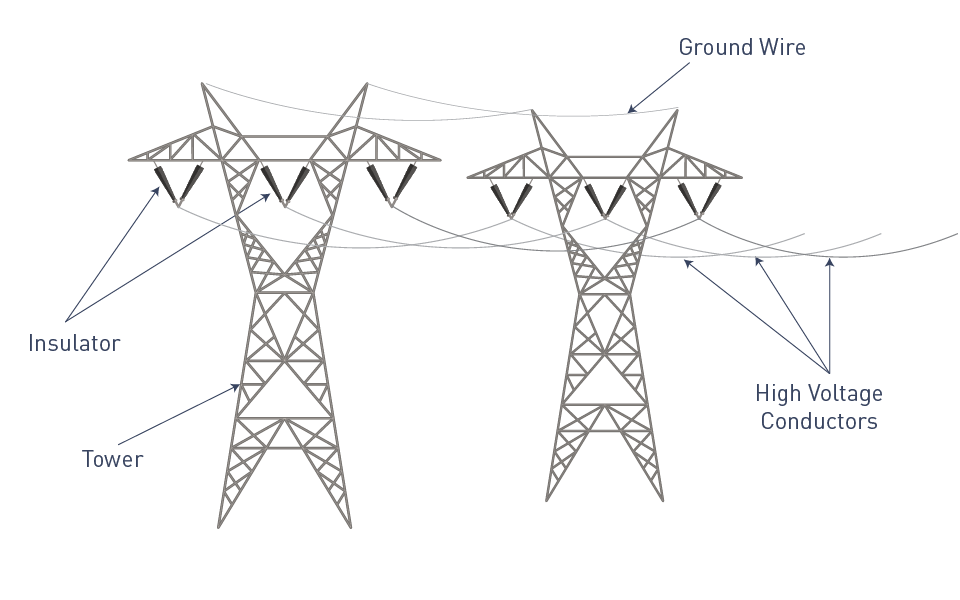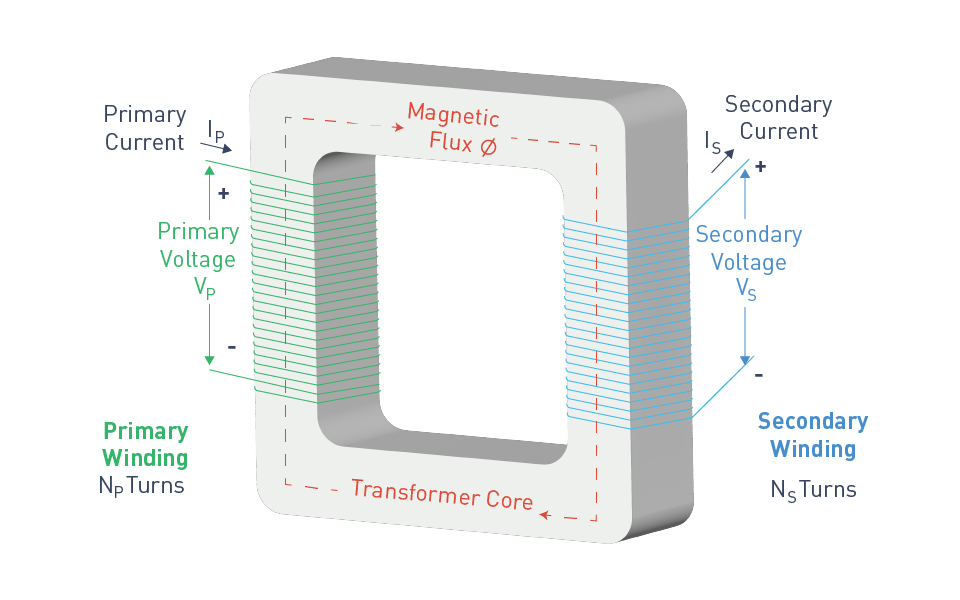Components of Power Transmission Systems
Transmission Lines
High-voltage lines are the most visible components of transmission systems, carrying electricity across long distances. They are intended to work at a variety of voltage levels, often ranging from 69kV to 765kV or more, in order to reduce energy losses during transmission.

Figure 15: high-voltage transmission
Substations
These facilities play an important role in electricity transmission, performing services such as voltage transformation, switching, and control. Substations regulate the voltage levels of electrical power, increasing it for effective long-distance transmission and decreasing it for distribution to consumers.

Figure 16: elements of a Substation
Elements of a substation:
A. Primary power lines’ side
B. Secondary power lines’ side
- Primary power lines
- Ground wire
- Overhead lines
- Transformer for measurement of electric voltage
- Disconnect switch
- Circuit breaker
- Current transformer
- Lightning arrester
- Main transformer
- Control building
- Security fence
- Secondary power lines
Transformers
Transformers play an important role in transmission systems because they allow for the voltage level modifications required for effective power transmission. Step-up transformers raise voltage levels on the generating side to reduce energy losses, whereas step-down transformers lower voltage levels to ensure safe distribution and consumption.

Figure 17: Ideal transformer
Switchgear and Control Equipment
These components are critical to the safety and control of power transmission systems. Switchgear manages, protects, and isolates a power system using a number of controls enclosed in a metal container. Fuses, switches, circuit breakers, and power conductors are all examples of switchgear components. Switchgear provides for the isolation of network components for maintenance and fault prevention, whilst control equipment regulates the flow of energy through the system, assuring stability and dependability.
Insulators
Insulators are materials that resist the flow of electricity, making them essential for separating electrical wires from one another and supporting structures. Insulators in transmission lines prevent high-voltage wires from shorting out to earth or each other. Glass, porcelain, and composite polymers are popular materials because of their excellent insulation and resistance to environmental stresses.
High-Voltage Transmission Systems and their Significance in Reducing Power Losses
High-voltage transmission systems are crucial to the effective distribution of electrical power across large distances. High voltage power transmission is a key engineering method for minimizing energy losses that occur when electricity is transported from power generation plants to consumers. This section examines the role of high-voltage transmission networks in lowering power losses, as well as the underlying concepts that make them a crucial component of the modern electrical grid.
Principle of High-Voltage Transmission
The argument for employing high voltage in transmission networks is based on the physics of electrical power and transmission. The electrical power transmitted along a line is the product of current (I) and voltage (V), and the power loss in the form of heat owing to resistance (R) in the line is provided by I2R. Before long-distance transmission, step-up transformers are used to increase the voltage, lowering the current. The transmitting Using higher voltages and lower currents for the same power level can dramatically minimize I2R losses. This is because power loss is equal to the square of the current; hence, a minor drop in current can result in a significant reduction in power loss.
Implementation and Advantages
To accomplish high-voltage transmission, step-up transformers are employed at the generating site to raise the voltage to levels ranging from 115 kV to 765 kV or more, depending on transmission distance and other system requirements. The high voltage electricity is subsequently transferred across large distances by overhead lines or, less often underground or submarine cables to substations near demand centers. Step-down transformers decrease voltage to levels appropriate for local distribution to end users.
The benefits of high-voltage transmission networks go beyond the decrease in power losses. These technologies also allow for the transfer of power over huge geographical distances, making it easier to integrate remote renewable energy resources into the grid and aid the connectivity of regional and national grids. Furthermore, by allowing the transfer of the same amount of power with less current, high-voltage systems can utilize thinner conductors, resulting in cheaper material costs and a smaller physical footprint for transmission lines.
Challenges and Considerations
Despite their benefits, high-voltage transmission systems present several challenges. These systems demand sophisticated technology and a large investment to build and maintain. Transformers, switchgear, and insulators are examples of high-voltage equipment that must be specifically constructed to withstand increasing stress while maintaining reliability and safety. Furthermore, the environmental and visual effect of overhead transmission lines, as well as the technical challenges that accompany underground and underwater cables, demand meticulous planning and involvement from the community.
Role of Substations in Stepping Up and Stepping Down Voltage Levels
Substations are crucial to the operation and efficiency of power transmission systems, serving as pivotal nodes for stepping up and stepping down voltage levels. This critical function guarantees that electrical power is transported over long distances as efficiently as possible and supplied to end users at safe and usable voltage levels. Understanding the operating dynamics and relevance of substations in the transmission system reveals their critical role in ensuring grid stability, reliability, and efficiency.
Stepping Up Voltage for Transmission
At the generating site, electricity is produced at relatively low voltage levels, making it unsuitable for long-distance transmission due to potential power losses. To solve this, substations with step-up transformers raise the voltage to far greater levels. Increasing the voltage reduces the current needed to carry the same amount of power, leading to lower transmission losses (I2R). High-voltage transmission is a critical component of modern power distribution strategies, allowing for the effective transmission of electricity across broad geographical regions, from remote generating sites to metropolitan centers and industrial enterprises.
Stepping Down Voltage for Distribution
Once electrical power reaches its destination, it must be converted back to lower voltage levels to ensure safe distribution and usage. Substations in consumer regions or at important places in the distribution network feature step-down transformers that decrease high transmission voltages to levels appropriate for commercial and residential use. This stepped-down voltage is then distributed through a network of smaller substations and transformers, gradually lowering the voltage to meet the specific needs of various end users, ranging from industrial complexes requiring medium-voltage power to individual households that typically use lower voltages.
Ensuring Grid Stability and Flexibility
Substations not only convert power but also function as electrical grid control centers. They have been equipped with switchgear, protective devices, and control systems that regulate the flow of electricity, isolate faults, and ensure overall grid stability. Substations help to improve the reliability and flexibility of the power system by monitoring and modifying the electrical properties of the electricity that passes through them. They enable the integration of renewable energy sources, load balancing, and power restoration after outages.
Operation of Power Transmission Systems
The operation of power transmission networks is defined by the problem of balancing electricity demand and supply in real time. This includes constant monitoring and control to modify power flow, respond to variations in demand, and handle network issues. Advanced technologies, including as Supervisory Control and Data Acquisition (SCADA) systems and phasor measurement units (PMUs), give grid operators with real-time data and control capabilities, ensuring system stability and efficiency.
Challenges in Power Transmission
Power transmission systems experience a variety of issues, including:
Energy Losses: Despite the effectiveness of high-voltage transmission, some energy is lost as heat as a result of line resistance. Minimizing these losses is a major engineering challenge.
Infrastructure Aging and Capacity: Many transmission lines rely on old infrastructure that was not built to satisfy current demand or successfully incorporate renewable energy sources.
Environmental and Social Impact: Construction of additional transmission lines is frequently opposed because of issues related to impact on the environment, land usage, and aesthetics.
Security and Reliability: Natural disasters, physical and cyber attacks, and equipment failures all have the potential to interrupt transmission systems. Ensuring the security and reliability of these systems is essential.


直接登录
创建新帐号